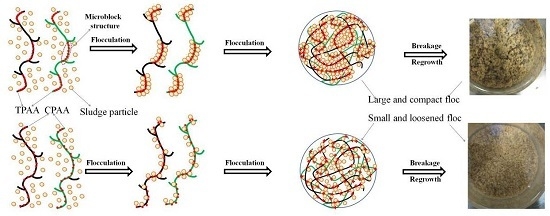Effect of the Cationic Block Structure on the Characteristics of Sludge Flocs Formed by Charge Neutralization and Patching
Abstract
:1. Introduction
2. Materials and Methods
2.1. Materials
2.2. Synthesis and Characteristics of Copolymers
2.3. Determination of theMonomer Reactivity Ratio and Composition
2.4. Determination of the Sequence Distributions
2.5. Flocculation Tests
2.5.1. Sludge and Flocculants
2.5.2. Jar Test
2.5.3. Floc Formation, Breakage, and Regrowth
3. Results and Discussion
3.1. The Monomer Reactivity Ratio and Composition
3.2. The Sequence Distributions of the Polymers
3.3. Characterization of the Flocculants
3.3.1. FT-IR Spectral Analysis
3.3.2. 1H NMR Spectral Analysis
3.3.3. 13C NMR Spectral Analysis
3.3.4. Thermogravimetry/Differential Scanning Calorimetry Analysis
3.4. Flocculation Performance
3.4.1. Zeta Potential
3.4.2. Floc Formation, Breakage, and Regrowth
3.4.3. Fractal Dimension
3.4.4. Floc Size Distribution
3.4.5. Sludge Dewatering with the Floc Fractal Dimension
3.5. Flocculation Mechanism
4. Conclusions
Supplementary Materials
Acknowledgments
Author Contributions
Conflicts of Interest
References
- Yang, Z.; Yan, H.; Yang, H.; Li, H.B.; Li, A.M.; Cheng, R.S. Flocculation performance and mechanism of graphene oxide for removal of various contaminants from water. WATER Res. 2013, 47, 3037–3046. [Google Scholar] [CrossRef] [PubMed]
- Runkana, V.; Somasundaran, P.; Kapur, P.C. Mathematical modeling of polymer-induced flocculation by charge neutralization. Chem. Eng. J. 2004, 270, 347–358. [Google Scholar] [CrossRef]
- Gupta, S.K.; Nayunigari, M.K.; Misra, R.; Ansari, F.A.; Dionysiou, D.D.; Maity, A.; Bux, F. Synthesis and Performance Evaluation of a New Polymeric Composite for the Treatment of Textile Wastewater. Ind. Eng. Chem. Res. 2016, 55, 13–20. [Google Scholar] [CrossRef]
- Liimatainen, H.; Sirviö, J.; Sundman, O.; Visanko, M.; Hormi, O.; Niinimäki. Flocculation performance of a cationic biopolymer derived from a cellulosic source in mild aqueous solution. J. Bioresour. Technol. 2011, 102, 9626–9632. [Google Scholar] [CrossRef] [PubMed]
- Zheng, H.L.; Sun, Y.J.; Zhu, C.J.; Guo, J.; Zhao, C.; Liao, Y.; Guan, Q.Q. UV-initiated polymerization of hydrophobically associating cationic flocculants: Synthesis, characterization, and dewatering properties. Chem. Eng. J. 2013, 234, 318–326. [Google Scholar] [CrossRef]
- Thapa, B.; Qi, Y.; Hoadley, A.F.A. Interaction of polyelectrolyte with digested sewage sludge and lignite in sludge dewatering. Colloids Surf. A Physicochem. Eng. Asp. 2009, 334, 66–73. [Google Scholar] [CrossRef]
- Bolto, B.; Gregory, J. Organic polyelectrolytes in water treatment. WATER Res. 2007, 41, 2301–2324. [Google Scholar] [CrossRef] [PubMed]
- Hjorth, M.; Jørgensen, B.U. Polymer flocculation mechanism in animal slurry establishedby charge neutralization. WATER Res. 2012, 46, 1045–1051. [Google Scholar] [CrossRef] [PubMed]
- Guan, Q.Q.; Zheng, H.L.; Zhai, J.; Zhao, C.; Zheng, X.K.; Tang, X.M.; Chen, W.; Sun, Y.J. Effect of Template on Structure and Properties of Cationic Polyacrylamide: Characterization and Mechanism. Ind. Eng. Chem. Res. 2014, 53, 5624–5635. [Google Scholar] [CrossRef]
- Zhang, Y.X.; Wu, F.P.; Li, M.Z.; Wang, E.J. Novel Approach to Synthesizing Hydrophobically Associating Copolymer Using Template Copolymerization: The Synthesis and Behaviors of Acrylamide and 4-(ω-Propenoyloxyethoxy) Benzoic Acid Copolymer. J. Phys. Chem. B. 2005, 109, 22250–22255. [Google Scholar] [CrossRef] [PubMed]
- Zhao, C.L.; Zheng, H.L.; Feng, L.; Wang, Y.L.; Liu, Y.Z.; Liu, B.Z.; Djibrine, B.Z. Improvement of Sludge Dewaterability by Ultrasound-Initiated Cationic Polyacrylamide with Microblock Structure: The Role of Surface-Active Monomers. Materials 2017, 10, 282. [Google Scholar] [CrossRef]
- Feng, L.; Zheng, H.L.; Gao, B.Y.; Zhao, C.L.; Zhang, S.X.; Chen, N. Enhancement of textile-dyeing sludge dewaterability using a novel cationic polyacrylamide: Role of cationic block structure. RSC Adv. 2017, 7, 11626–11635. [Google Scholar] [CrossRef]
- Sun, Y.J.; Zheng, H.L.; Zhai, J.; Teng, H.K.; Zhao, C.; Zhao, C.L.; Liao, Y. Effects of Surfactants on the Improvement of Sludge Dewaterability Using Cationic Flocculants. PLoS ONE 2014, 9, 10. [Google Scholar] [CrossRef] [PubMed]
- Han, K.H.; Jeon, G.S.; Hong, I.K.; Lee, S.B. Prediction of solubility parameter from intrinsic viscosity. J. Ind. Eng. Chem. 2013, 19, 1130–1136. [Google Scholar] [CrossRef]
- Ren, H.J.; Chen, W.N.; Zheng, Y.F.; Luan, Z.K. Effect of hydrophobic group on flocculation properties and dewatering efficiency of cationic acrylamide copolymers. React. Funct. Polym. 2007, 67, 601–608. [Google Scholar] [CrossRef]
- Wang, X.M.; Li, M.H.; Song, X.J.; Chen, Z.H.; Wu, B.D.; Zhang, S.J. Preparation and Evaluation of Titanium-Based Xerogel as a Promising Coagulant for Water/Wastewater Treatment. Environ. Sci. Technol. 2016, 50, 9619–9626. [Google Scholar] [CrossRef] [PubMed]
- Zhao, Y.X.; Gao, B.Y.; Rong, H.Y.; Shon, H.K.; Kim, J.H.; Yue, Q.Y.; Wang, Y. The impacts of coagulant aid-polydimethyldiallylammonium chloride on coagulation performances and floc characteristics in humic acid-kaolin synthetic water treatment with titanium tetrachloride. Chem. Eng. J. 2011, 173, 376–384. [Google Scholar] [CrossRef]
- Li, Z.L.; Zhang, D.J.; Lu, P.L.; Zeng, S.W.; Yang, Y.H. Influencing factors of floc size distribution and fractal dimension of activated sludge. Environ. Sci. 2013, 34, 3975–3980. [Google Scholar]
- Zhao, P.T.; Ge, S.F.; Chen, Z.Q.; Li, X. Study on pore characteristics of flocs and sludge dewaterability based on fractal methods (pore characteristics of flocs and sludge dewatering). Appl. Therm. Eng. 2013, 58, 217–223. [Google Scholar] [CrossRef]
- Chen, W.; Zheng, H.L.; Guan, Q.Q.; Teng, H.K.; Zhao, C.L.; Zhao, C. Fabricating a Flocculant with Controllable Cationic Microblock Structure: Characterization and Sludge Conditioning Behavior Evaluation. Ind. Eng. Chem. Res. 2016, 55, 2892–2902. [Google Scholar] [CrossRef]
- Zhang, Z.A.; Zheng, H.L.; Huang, F.; Li, X.; He, S.; Zhao, C. Template Polymerization of a Novel Cationic Polyacrylamide: Sequence Distribution, Characterization, and Flocculation Performance. Ind. Eng. Chem. Res. 2016, 55, 9819–9828. [Google Scholar] [CrossRef]
- Liao, Y.; Zheng, H.L.; Qian, L.; Sun, Y.J.; Dai, L.; Xue, W.W. UV-Initiated Polymerization of Hydrophobically Associating Cationic Polyacrylamide Modified by a Surface-Active Monomer: A Comparative Study of Synthesis, Characterization, and Sludge Dewatering Performance. Ind. Eng. Chem. Res. 2014, 53, 11193–11203. [Google Scholar] [CrossRef]
- Li, X.; Zheng, H.L.; Gao, B.Y.; Sun, Y.J.; Tang, X.M.; Xu, B.C. Optimized preparation of micro-block CPAM by response surface methodology and evaluation of dewatering performance. RSC Adv. 2017, 7, 208–217. [Google Scholar] [CrossRef]
- Pourjavadi, A.; Mahmoud, S.; Seyed, F.; Hassan, H. Novel cationic-modified salep as an efficient flocculating agent for settling of cement slurries. Carbohydr. Polym. 2013, 93, 506–511. [Google Scholar] [CrossRef] [PubMed]
- Abdollahi, Z.; Frounchi, M.; Dadbin, S. Synthesis, characterization and comparison of PAM, cationic PDMC and P(AM-co-DMC) based on solution polymerization. J. Ind. Eng. Chem. 2011, 17, 580–586. [Google Scholar] [CrossRef]
- Li, X.; Zheng, H.L.; Gao, B.Y.; Sun, Y.J.; Liu, B.Z.; Zhao, C.L. UV-initiated template copolymerization of AM and MAPTAC: Microblock structure, copolymerization mechanism, and flocculation performance. Chemosphere 2017, 167, 71–81. [Google Scholar] [CrossRef] [PubMed]
- Zhang, S.; Huang, G.S.; Wu, J.R. Rheological Properties of Template Polymerization Polyacrylamide Aqueous Solutions. J. Macromol. Sci. Part B Phys. 2011, 50, 2203–2213. [Google Scholar] [CrossRef]
- Wang, D.F.; Zhao, T.Q.; Yan, L.Q.; Mi, Z.M.; Gu, Q.; Zhang, Y.M. Synthesis, characterization and evaluation of dewatering properties of chitosan-grafting DMDAAC flocculants. Int. J. Biol. Macromol. 2016, 92, 761–768. [Google Scholar] [CrossRef] [PubMed]
- Sun, Y.J.; Ren, M.J.; Zhu, C.Y.; Xu, Y.H.; Zheng, H.L.; Xiao, X.F.; Wu, H.; Xia, T.; You, Z.Y. Treatment of Zinc Phosphate-Contaminated Wastewater. Ind. Eng. Chem. Res. 2016, 55, 10025–10035. [Google Scholar] [CrossRef]
- Harif, T.; Khai, M.; Adin, A. Electrocoagulation versus chemical coagulation: Coagulation/flocculation mechanisms and resulting floc characteristics. WATER Res. 2012, 46, 3177–3188. [Google Scholar] [CrossRef] [PubMed]
- Nan, J.; Yao, M.; Chen, T.; Li, S.N.; Wang, Z.B.; Feng, G. Breakage and regrowth of flocs formed by sweep coagulation using additional coagulant of poly aluminium chloride and non-ionic polyacrylamide. Environ. Sci. Pollut. Res. 2016, 23, 16336–16348. [Google Scholar] [CrossRef] [PubMed]
- Mao, R.R.; Wang, Y.; Zhang, B.; Xu, W.Y.; Dong, M.; Gao, B.Y. Impact of enhanced coagulation ways on flocs properties and membrane fouling: Increasing dosage and applying new composite coagulant. Desalination 2013, 314, 161–168. [Google Scholar] [CrossRef]
- Zhong, R.S.; Zhang, X.H.; Xiao, F.; Li, X.Y.; Cai, Z.H. Effects of humic acid on physical and hydrodynamic properties of kaolin flocs by particle image velocimetry. WATER Res. 2011, 45, 3981–3990. [Google Scholar] [CrossRef] [PubMed]
- Zhao, Y.X.; Wang, Y.; Gao, B.Y.; Shon, H.K.; Kim, J.-H.; Yue, Q.Y. Coagulation performance evaluation of sodium alginate used as coagulant aid with aluminum sulfate, iron chloride and titanium tetrachloride. Desalination 2012, 299, 79–88. [Google Scholar] [CrossRef]
- Niu, M.Q.; Zhang, W.J.; Wang, D.S.; Chen, Y.; Chen, R.L. Correlation of physicochemical properties and sludge dewaterability under chemical conditioning using inorganic coagulants. Bioresour. Technol. 2013, 144, 337–343. [Google Scholar] [CrossRef] [PubMed]
- Avadiar, L.; Leong, Y.K.; Fourie, A. Effects of polyethylenimine dosages and molecular weights on flocculation, rheology and consolidation behaviors of kaolin slurries. Powder Technol. 2014, 254, 364–372. [Google Scholar] [CrossRef]
- Wu, Y.; Zhang, P.Y.; Zhang, H.B.; Zeng, G.M.; Liu, J.B.; Ye, J.; Fang, W.; Gou, X.Y. Possibility of sludge conditioning and dewatering with rice husk biochar modified by ferric chloride. Bioresour. Technol. 2016, 205, 258–263. [Google Scholar] [CrossRef] [PubMed]
- Luo, H.J.; Ning, X.A.; Liang, X.J.; Feng, Y.F.; Liu, J.Y. Effects of sawdust-CPAM on textile dyeing sludge dewaterability and filter cake properties. Bioresour. Technol. 2013, 139, 330–336. [Google Scholar] [CrossRef] [PubMed]

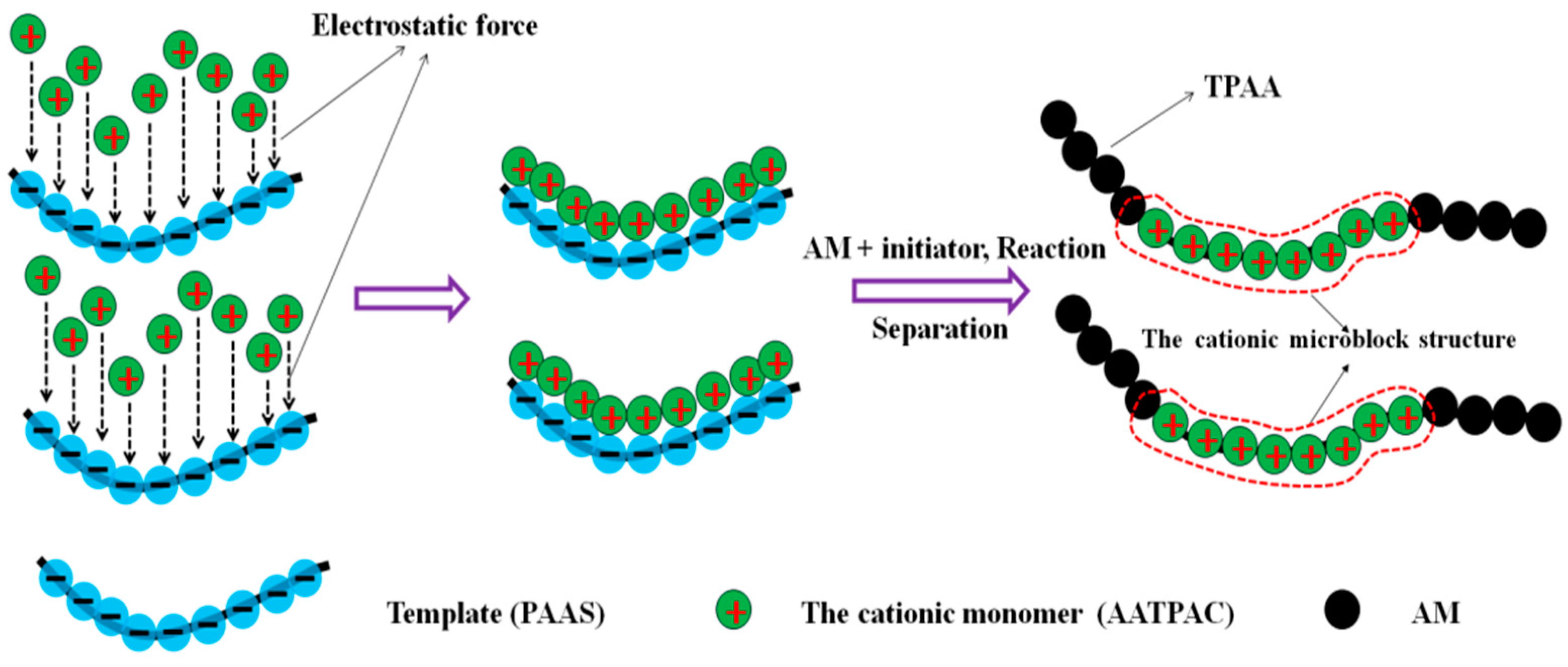
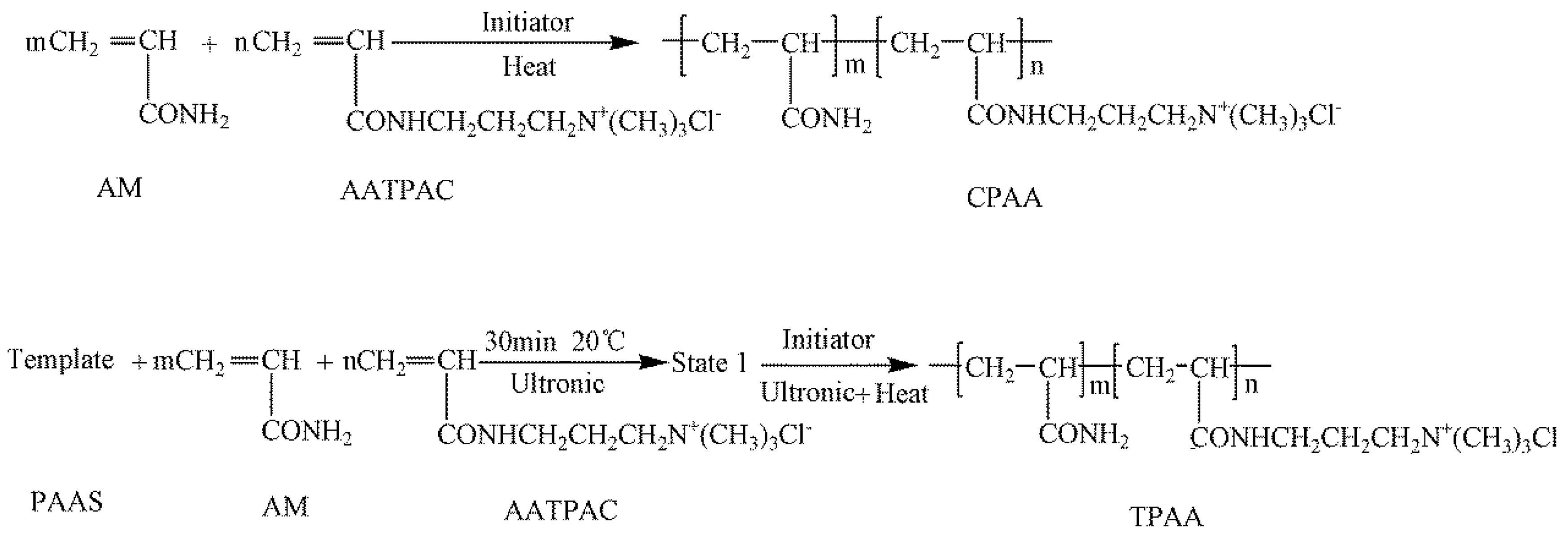

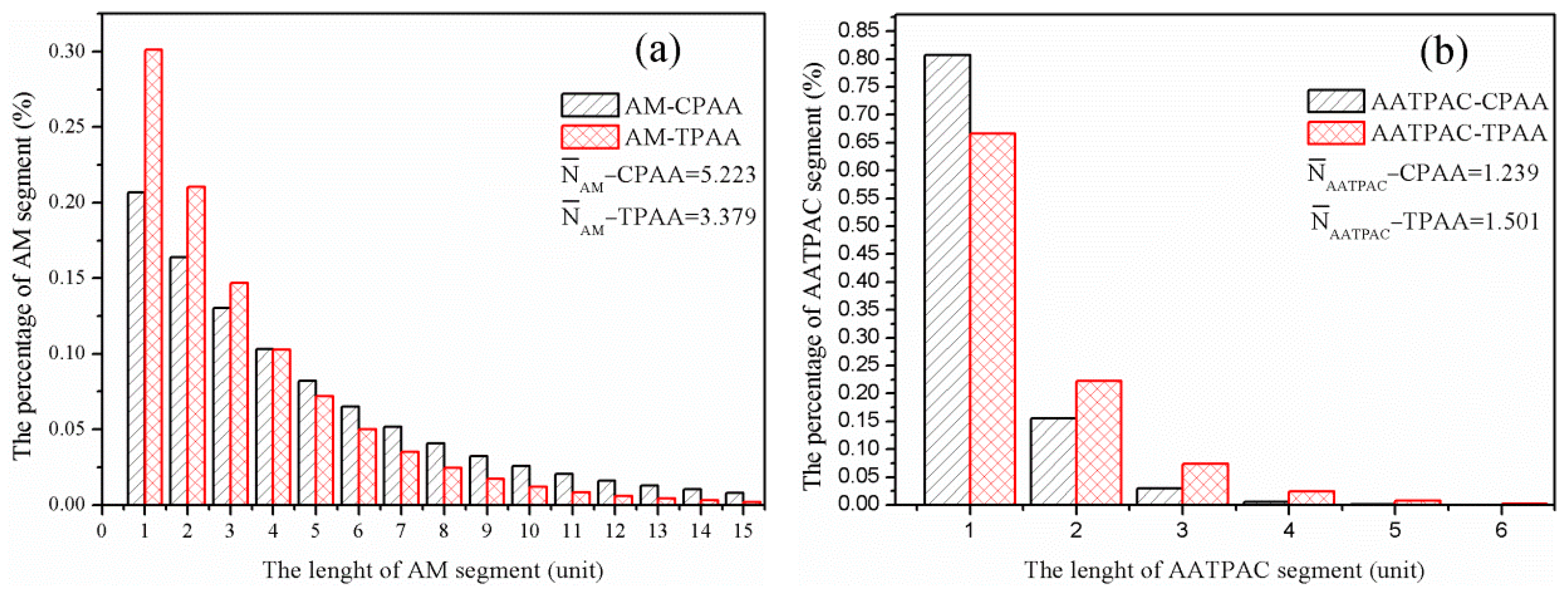
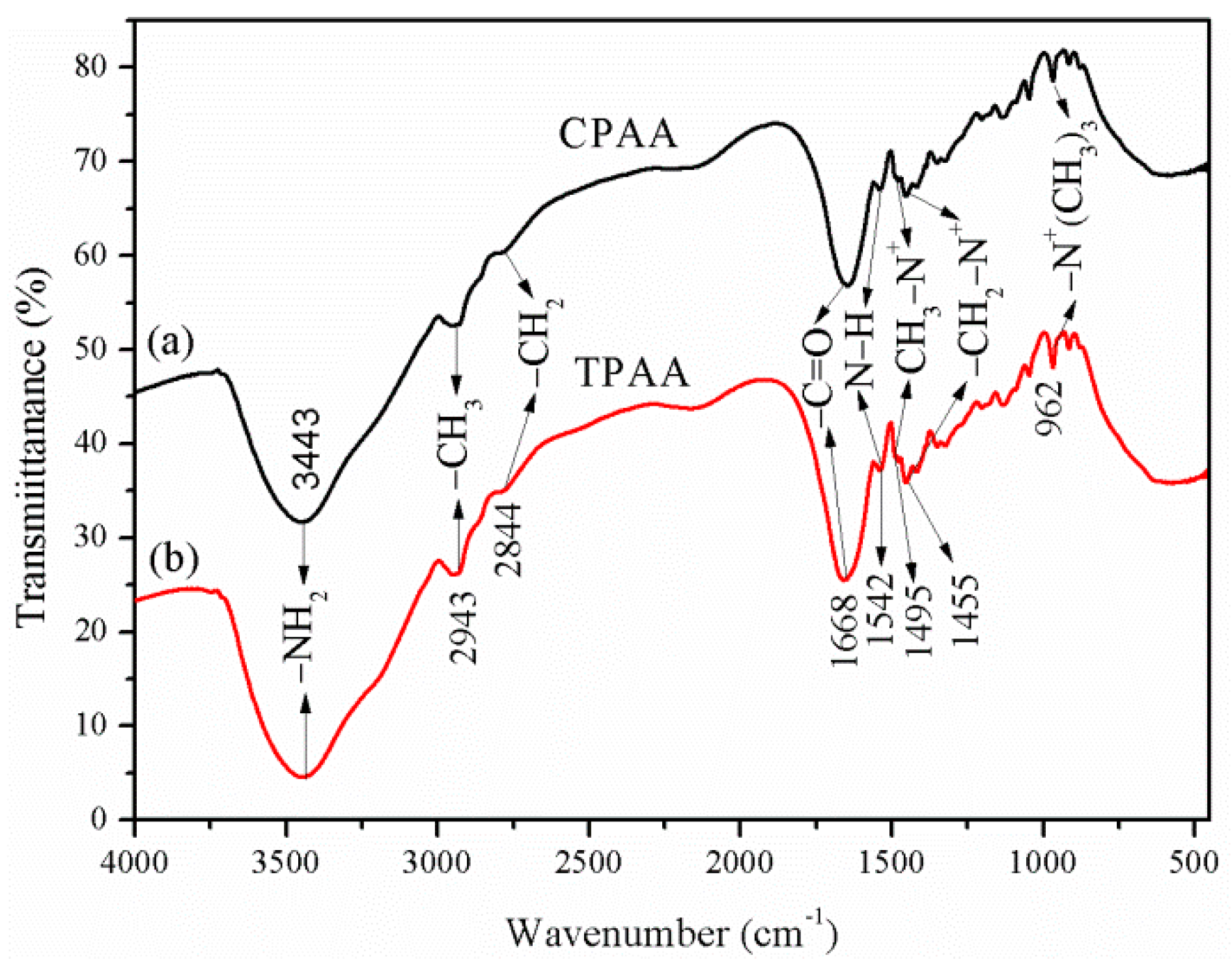

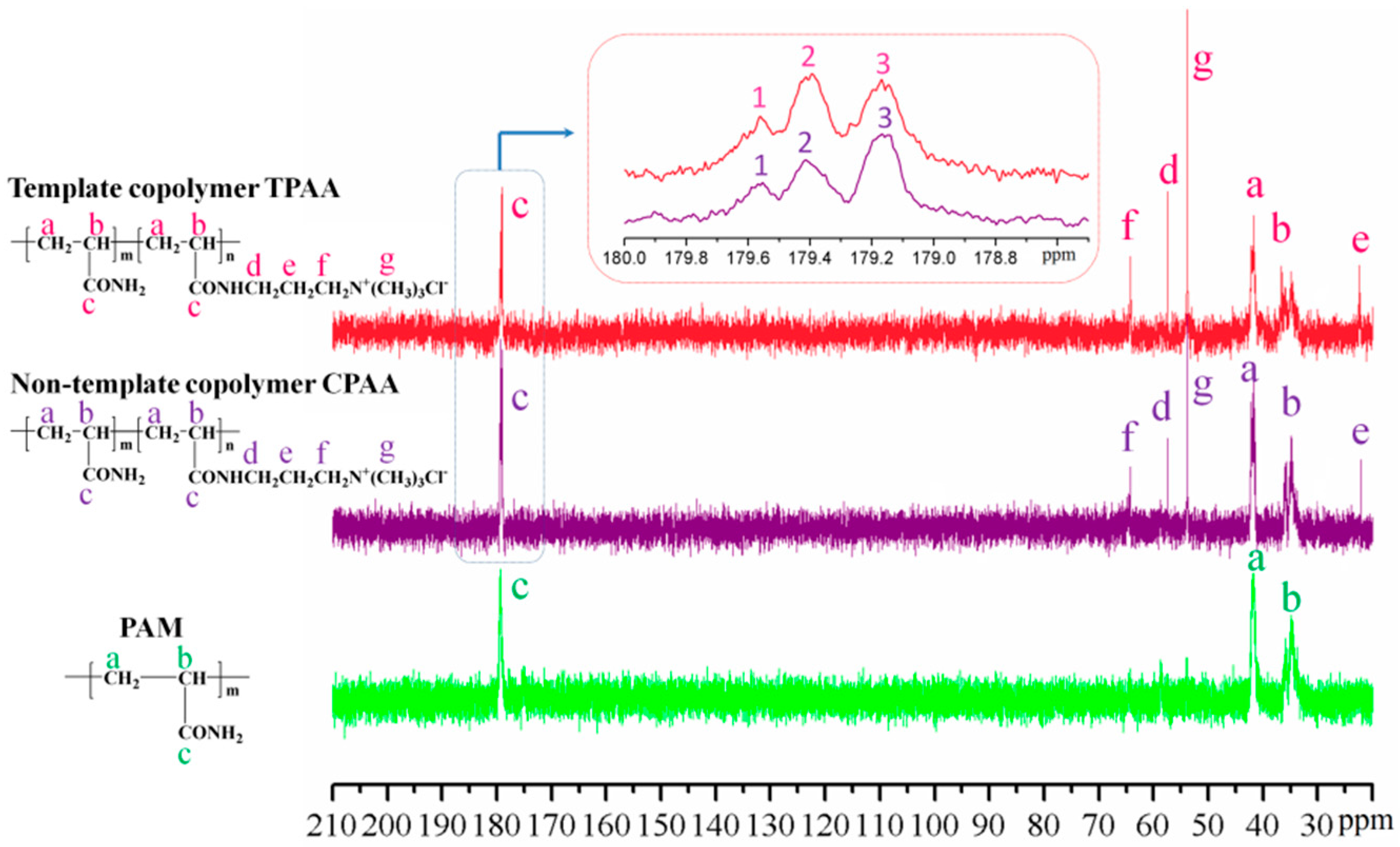
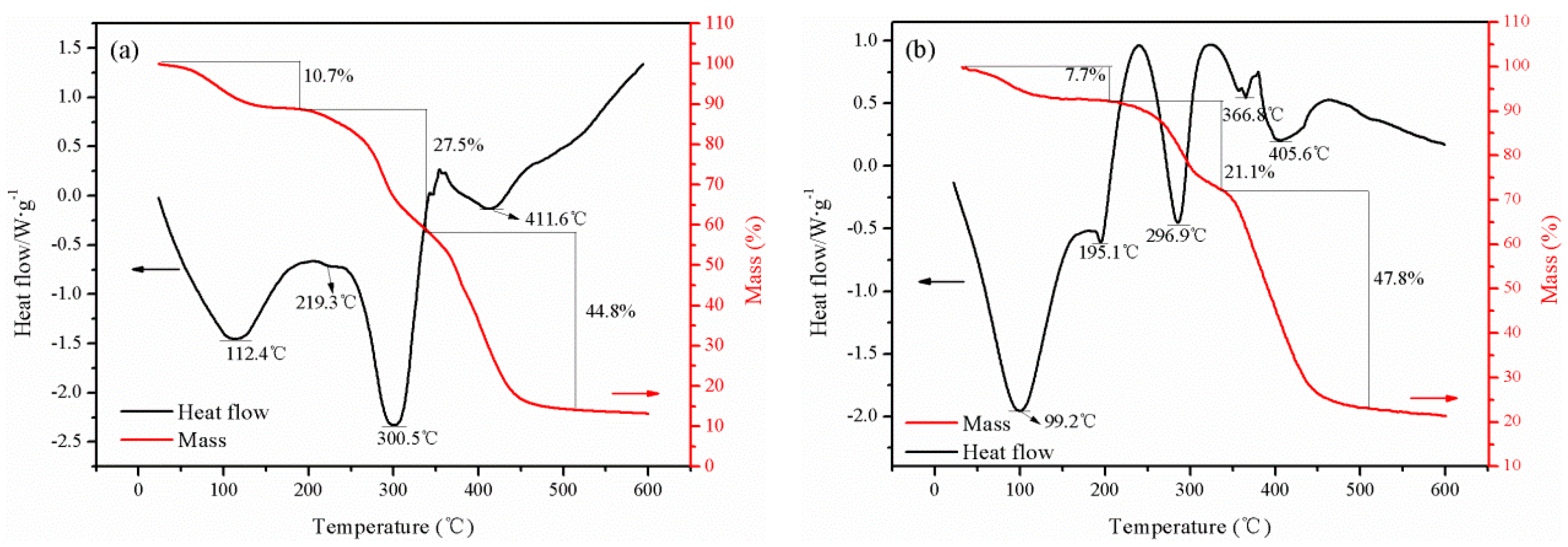
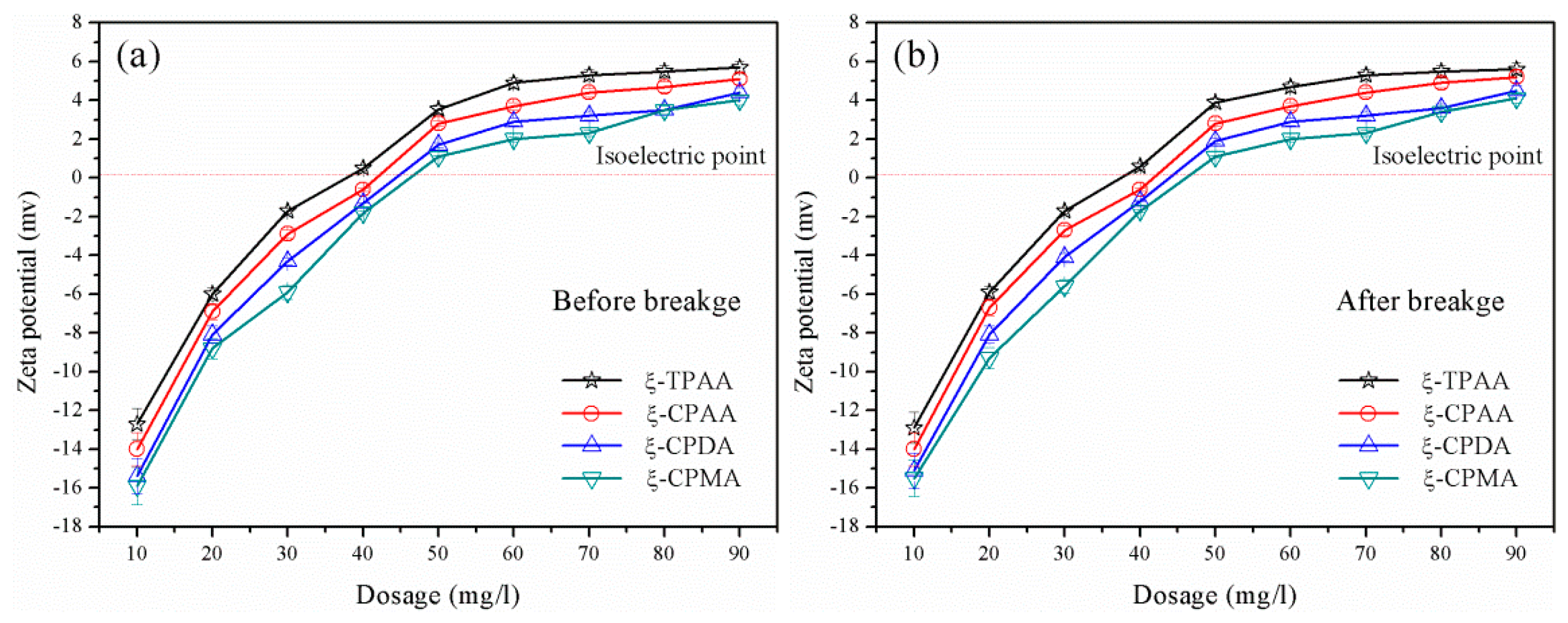

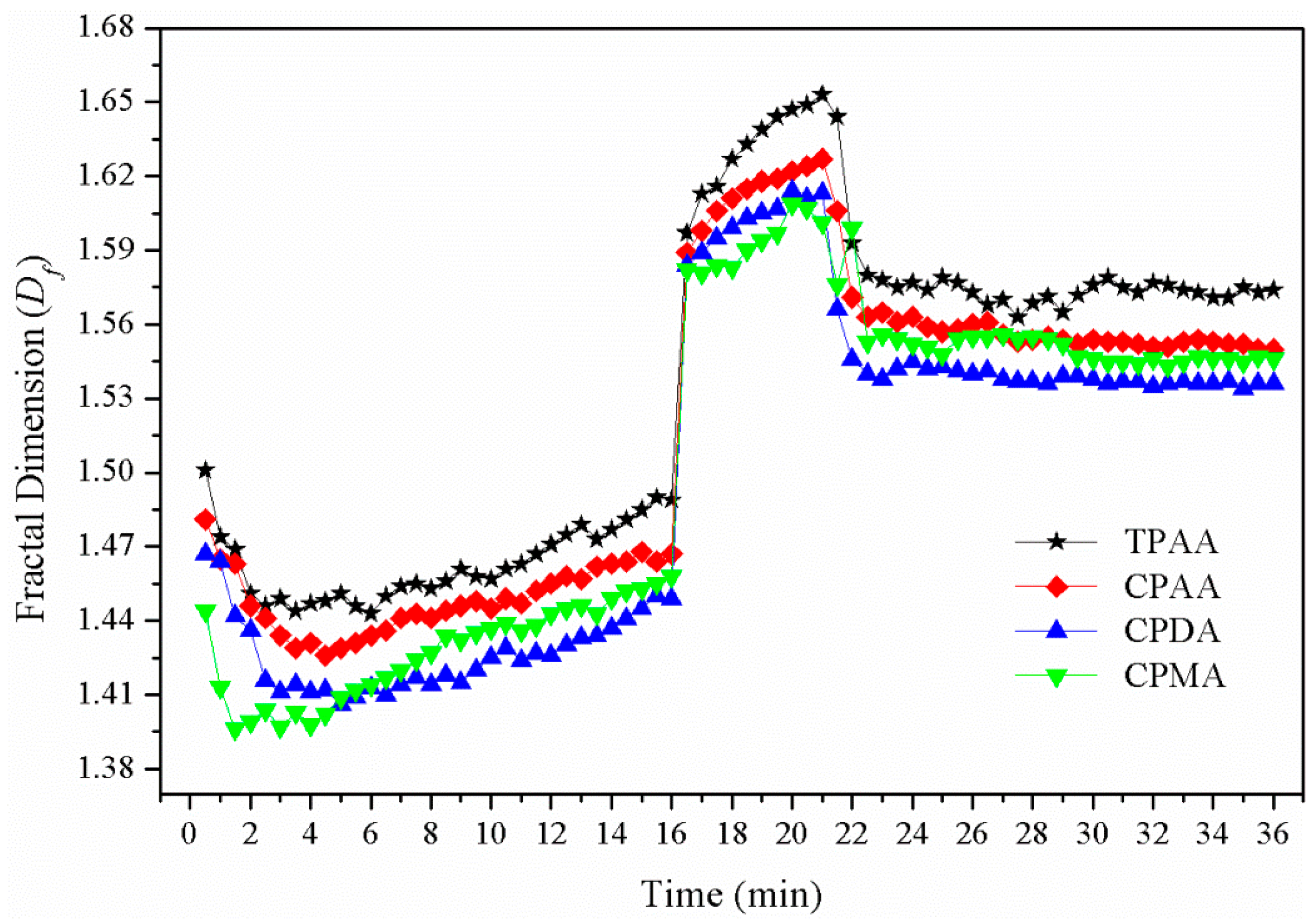
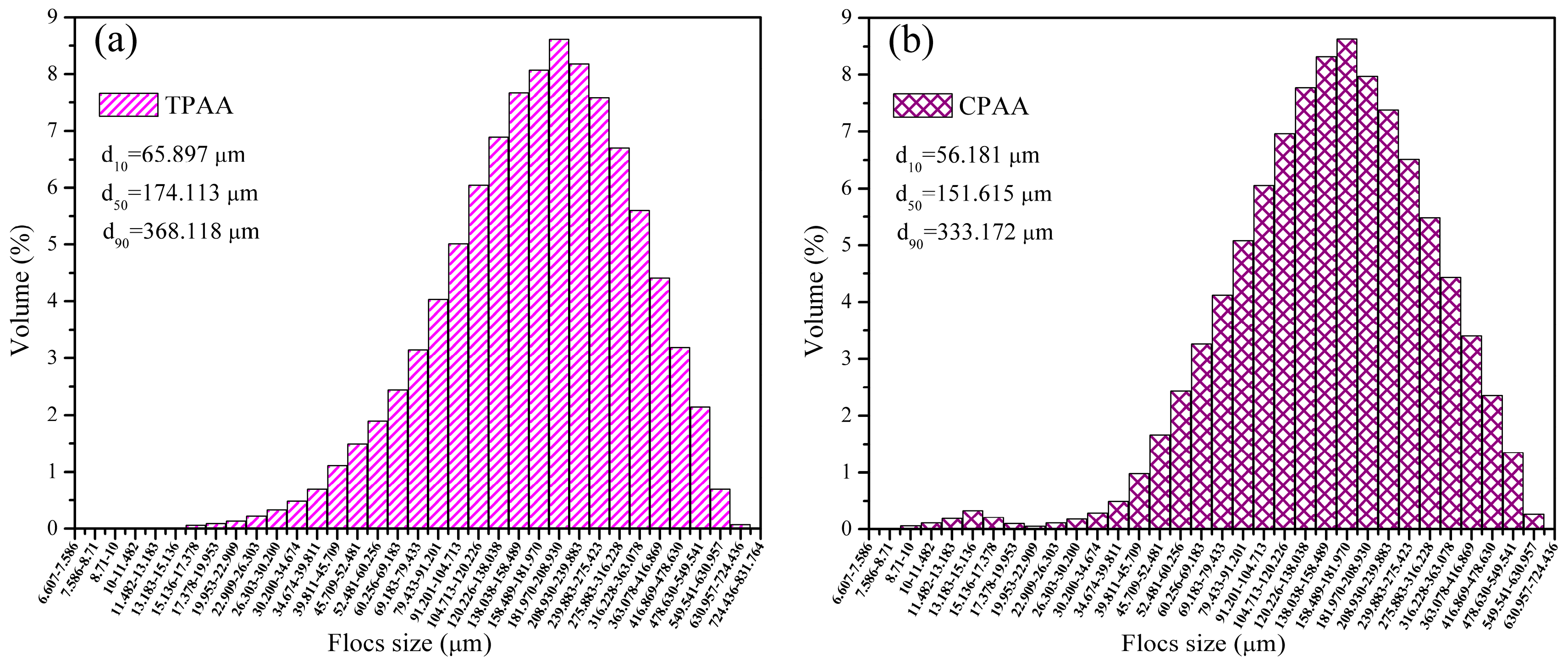
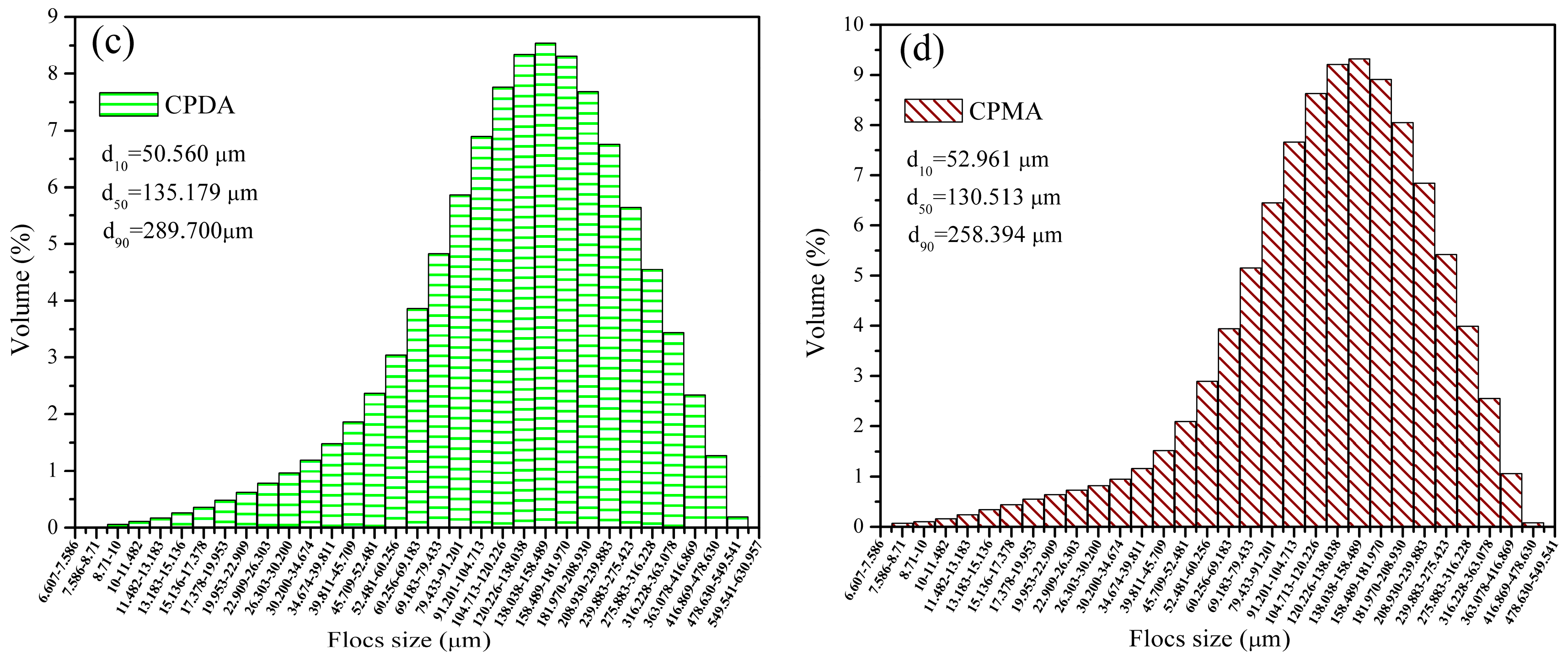
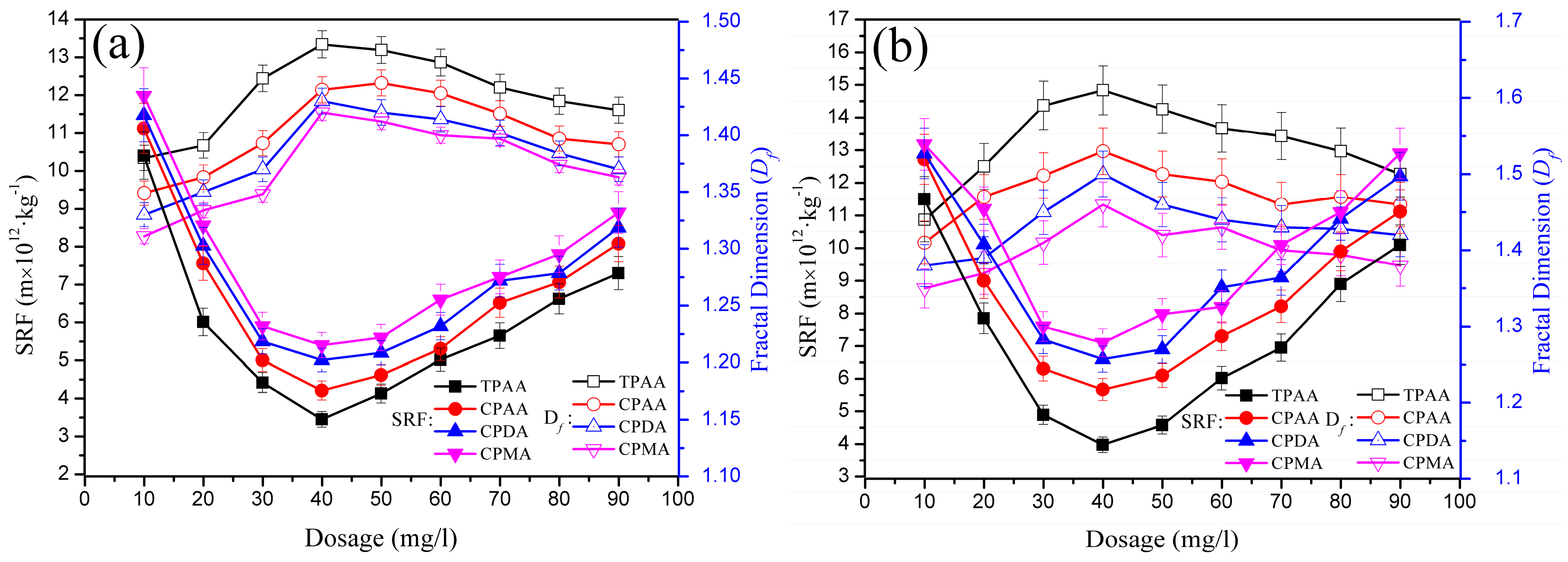
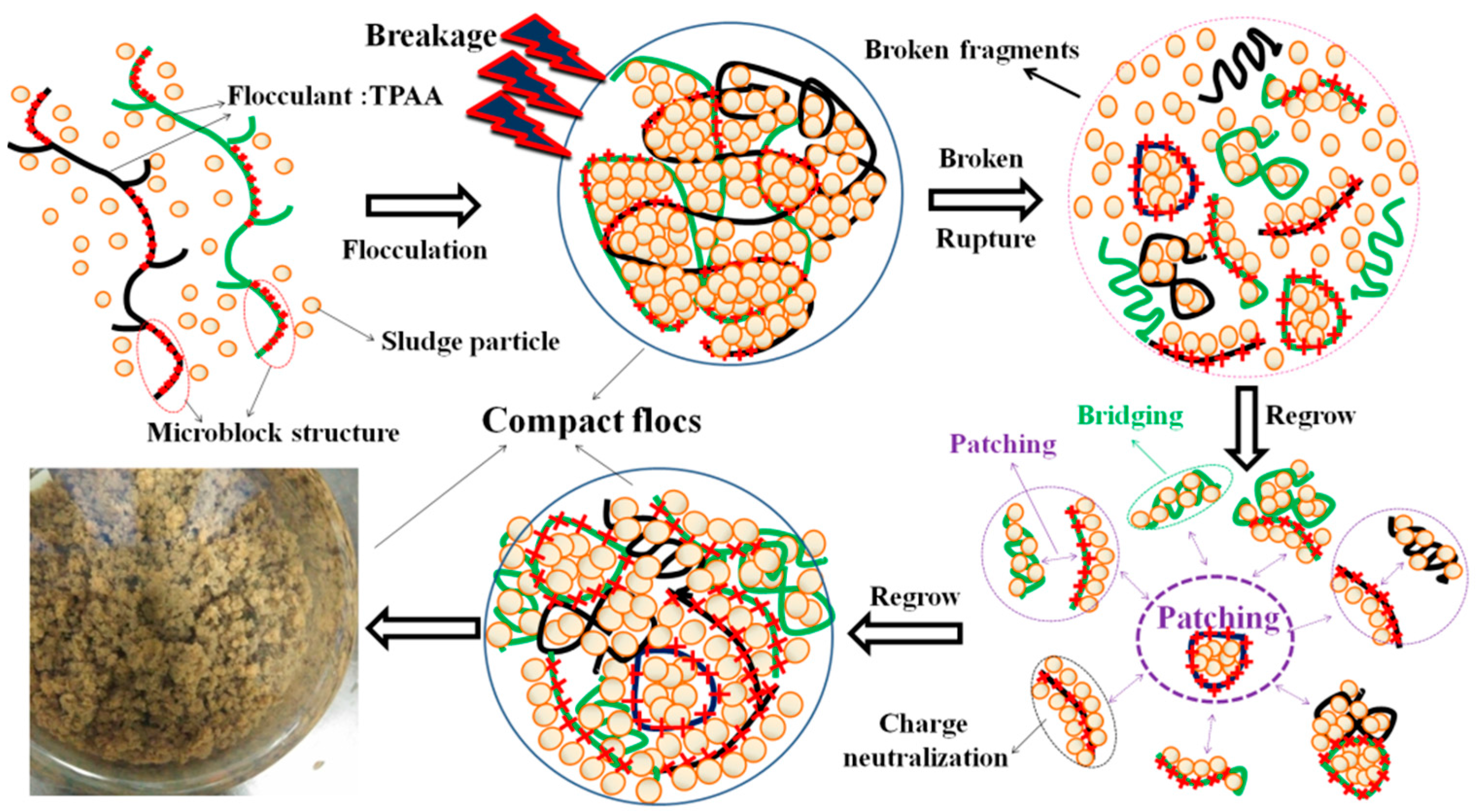
| pH | Zeta Potential (mV) | Mass Density (g·mL−1) | Moisture Content (%) | VSS/TSS |
|---|---|---|---|---|
| 7.10 | −22.30 | 1.038 | 0.996 | 0.771 |
| Kelen-Tüdӧs Method [20] | ||
|---|---|---|
| Copolymer | rAM | rAATPAC |
| CPAA | 2.815 | 0.358 |
| TPAA | 1.586 | 0.751 |
| MestReNova Software Method | ||
|---|---|---|
| Copolymer | TAT (%) | AAT (%) |
| TPAA | 9.1 | 48.1 |
| CPAA | 6.3 | 36.3 |
© 2017 by the authors. Licensee MDPI, Basel, Switzerland. This article is an open access article distributed under the terms and conditions of the Creative Commons Attribution (CC BY) license (http://creativecommons.org/licenses/by/4.0/).
Share and Cite
Zheng, H.; Feng, L.; Gao, B.; Zhou, Y.; Zhang, S.; Xu, B. Effect of the Cationic Block Structure on the Characteristics of Sludge Flocs Formed by Charge Neutralization and Patching. Materials 2017, 10, 487. https://doi.org/10.3390/ma10050487
Zheng H, Feng L, Gao B, Zhou Y, Zhang S, Xu B. Effect of the Cationic Block Structure on the Characteristics of Sludge Flocs Formed by Charge Neutralization and Patching. Materials. 2017; 10(5):487. https://doi.org/10.3390/ma10050487
Chicago/Turabian StyleZheng, Huaili, Li Feng, Baoyu Gao, Yuhao Zhou, Shixin Zhang, and Bingchen Xu. 2017. "Effect of the Cationic Block Structure on the Characteristics of Sludge Flocs Formed by Charge Neutralization and Patching" Materials 10, no. 5: 487. https://doi.org/10.3390/ma10050487




